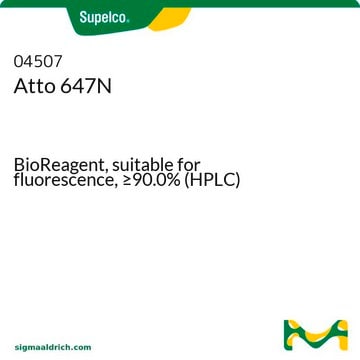06699
Atto 532
BioReagent, suitable for fluorescence, ≥90% (HPCE)
Se connecterpour consulter vos tarifs contractuels et ceux de votre entreprise/organisme
About This Item
Produits recommandés
Gamme de produits
BioReagent
Pureté
≥90% (HPCE)
Fabricant/nom de marque
ATTO-TEC GmbH
Fluorescence
λex 533 nm; λem 560 nm in 0.1 M phosphate pH 7.0
Adéquation
suitable for fluorescence
Température de stockage
−20°C
Description générale
Atto 532 hat eine molekulare Absorption von 115.000 und eine Quantenausbeute von 90% in Wasser, so dass er starke Fluoreszenz zeigt.
Die Abklingzeit der Fluoreszenz beträgt 3.8 ns.
Die Abklingzeit der Fluoreszenz beträgt 3.8 ns.
Application
Atto fluorescent labels are designed for high sensitivity applications, including single molecule detection. Atto labels have rigid structures that do not show any cis-trans-isomerization. Thus these labels display exceptional intensity with minimal spectral shift on conjugation.
Atto 532 has been conjugated with the secondary antibodies for STED (stimulated emission depletion) microscopy and immunofluorescence studies.
Atto 532 has been conjugated with the secondary antibodies for STED (stimulated emission depletion) microscopy and immunofluorescence studies.
Informations légales
This product is for Research use only. In case of intended commercialization, please contact the IP-holder (ATTO-TEC GmbH, Germany) for licensing.
Code de la classe de stockage
11 - Combustible Solids
Classe de danger pour l'eau (WGK)
WGK 3
Point d'éclair (°F)
Not applicable
Point d'éclair (°C)
Not applicable
Équipement de protection individuelle
Eyeshields, Gloves, type N95 (US)
Certificats d'analyse (COA)
Recherchez un Certificats d'analyse (COA) en saisissant le numéro de lot du produit. Les numéros de lot figurent sur l'étiquette du produit après les mots "Lot" ou "Batch".
Déjà en possession de ce produit ?
Retrouvez la documentation relative aux produits que vous avez récemment achetés dans la Bibliothèque de documents.
Les clients ont également consulté
3D reconstruction of high-resolution STED microscope images.
Punge A et al.
Microscopy Research and Technique, 71, 644-644 (2008)
Uffe V Schneider et al.
BMC biotechnology, 10, 4-4 (2010-01-28)
Melting temperature of DNA structures can be determined on the LightCycler using quenching of FAM. This method is very suitable for pH independent melting point (Tm) determination performed at basic or neutral pH, as a high throughput alternative to UV
STED microscopy reveals nanoparticle assemblies
Willig, K.I., et al.
New Journal of Physics, 8, 1-1 (2006)
Toshiro Saito et al.
Nanotechnology, 22(44), 445708-445708 (2011-10-13)
We fabricated platinum bowtie nanostructure arrays producing fluorescence enhancement and evaluated their performance using two-photon photoluminescence and single-molecule fluorescence measurements. A comprehensive selection of suitable materials was explored by electromagnetic simulation and Pt was chosen as the plasmonic material for
Evidence for major structural changes in subunit C of the vacuolar ATPase due to nucleotide binding.
Andrea Armbrüster et al.
FEBS letters, 579(9), 1961-1967 (2005-03-29)
The ability of subunit C of eukaryotic V-ATPases to bind ADP and ATP is demonstrated by photoaffinity labeling and fluorescence correlation spectroscopy (FCS). Quantitation of the photoaffinity and the FCS data indicate that the ATP-analogues bind more weakly to subunit
Notre équipe de scientifiques dispose d'une expérience dans tous les secteurs de la recherche, notamment en sciences de la vie, science des matériaux, synthèse chimique, chromatographie, analyse et dans de nombreux autres domaines..
Contacter notre Service technique








